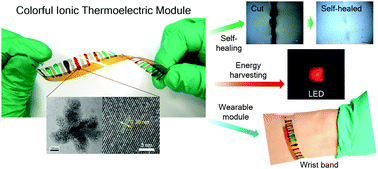Bisulfate transport in hydrogels for self-healable and transparent thermoelectric harvesting films†
Abstract
A wearable and transparent thermoelectric (TE) hydrogel based on bisulfate transport was demonstrated to record a negative ionic Seebeck coefficient of −25.0 mV K−1, ionic power factor of 9.94 mW m−1 K−2, and an ionic figure of merit of 7.2 at 80% relative humidity and room temperature. The n-type TE hydrogel was made of electronic poly(3,4-ethylenedioxythiophene), ionic poly(2-acrylamido-2-methyl-1-propanesulfonic acid), and biocompatible bisulfate, which was used as a thermally diffusive anion carrier for the first time in TE devices, to realize a soft mixed ionic–electronic conductor. The composition of this hydrogel was precisely controlled by varying the contents of ammonium persulfate and 3,4-ethylenedioxythiophene to afford a transparent and self-healable film that recovered within 15 min after cutting (cut width of ∼35 μm). Bisulfate transport was visualized using an anion detective fluorophore as a tool to intuitively elucidate the Soret effect, in which ion carriers thermodiffuse from hot to cold parts, and to quantify the thermovoltage simultaneously. A flexible band-type TE energy harvester with 20 legs was fabricated to afford a thermovoltage of −2.75 V at a temperature gradient of 5.5 K, and the harvested energy was used to operate a light-emitting diode for the first time in an organic TE module with a small temperature gradient (<10 K). Moreover, a colorful wearable band-type module and photothermal all organic TE device were demonstrated to be effective self-powered body-worn TE harvesters under ambient conditions.



 Please wait while we load your content...
Please wait while we load your content...